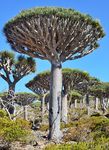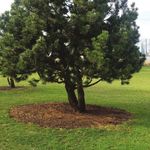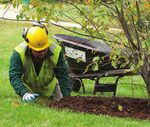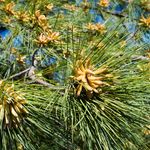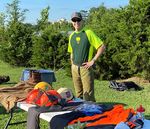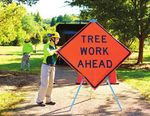TREE TIPS - Bartlett Tree Experts
←
→
Page content transcription
If your browser does not render page correctly, please read the page content below
TREE TIPS TREE & SHRUB CARE FROM BARTLETT TREE EXPERTS
Fall is for fertilization by Tom Smiley, PhD Phytophthora
Fall is a great time to fertilize trees the application of nutrients that are
Root Rot
and shrubs! With cooler temperatures not needed. To accomplish this, we Phytophthora root rot affects many
and regular rainfall, root development start with a site inspection and a soil species of woody landscape plants.
is usually vigorous at this time of the nutrient sample. If a soil analysis has The most susceptible species that
year. As roots grow, they can absorb not been conducted within the past are frequently infected include:
nutrients, which then are translocated three years, ask your Bartlett Arborist • azalea • boxwood
Representative to collect a sample and • conifers • daphne
Fertilization based on the results of send it to our laboratory for analysis. • dogwood • holly
soil nutrient analysis is best for both The report that you receive back will let • juniper • taxus
tree health and the environment. you know the conditions of your soil and • rhododendron
provide you and your Plant Health Care
Specialist with a detailed prescription of
to the leaves or stored until next the nutrients essential to maintain your
spring. When spring arrives, the new trees' health.
leaves and twigs will have a ready and
If you have had construction done
abundant source of nutrients that can
on your home or place of business, it
be used to produce the food that trees
may have resulted in soil compaction.
need to thrive.
Your Arborist Representative can
At Bartlett Tree Experts, we are also diagnose the soil condition in
interested in both tree health and the construction areas. If the soil is
environment. Our goal is to provide compacted, our Root InvigorationTM
the nutrients your plants need in the treatment can improve soil conditions to
Phytophthora root rot in a yew hedge.
amounts they need, while avoiding allow rapid root development.
Continued on page 2 Phytophthora derives its name from
the Greek language and literally
means “plant destroyer”. It’s a
fitting name for this pathogen.
A soil-borne microorganism,
Phytophthora species are more
closely related to brown algae than
to fungi. It grows and produces
spores under wet soil conditions.
The spores (known as zoospores)
have flagella that allow them to
move through a film of water.
Zoospores germinate and infect fine
roots. Sometimes, the pathogen
progresses into larger roots, the root
flare, and even into the stem. This
causes the death of the plant. Poorly
drained and/or persistently wet
soils favor the development of this
disease.
Continued on page 2Fall is for fertilization (Continued from page 1)
Applying a layer of organic it improves organic matter that encourages root growth.
mulch over the root system Arborist wood chips are one of the best forms of mulch
is one of the best actions available.
you can take at this time of
Bartlett Tree Experts provides a full line of soil care services
year to prepare your trees
that can improve the health of your trees and shrubs. Many
for winter. Mulch insulates the soil, allowing water and
of these services are best done in the fall. Now’s the time to
nutrient uptake further into the fall. As mulch breaks down,
arrange for a consultation.
Phytophthora Sharing chainsaw safety training
Root Rot Travis Black and Nathan Trull, Arborist Representatives from our Durham/Chapel
(Continued from page 1) Hill office, presented three chainsaw safety training sessions at the Landscape
Professional Field Day hosted by North Carolina State University’s Department
Plants with root disease appear as
of Horticulture and the JC Raulston Arboretum on June 23. Green industry
unhealthy; leaves will become yellow
professionals from across the state attended.
and stunted, and new growth slows.
The roots of affected plants are black They discussed personal protective equipment for operators, safety features of
and shriveled. the chainsaws, general maintenance, as well as proper starting and stopping, and
proper body positioning and stance for operating the chainsaw on the ground.
Phytophthora root rot is prevented
Participants received a tree seedling and a raffle ticket for a new pair of chainsaw
by planting trees and shrubs on well-
chaps with the drawing held at the end of the day.
drained soils that are amended with
organic matter. Monitoring irrigation Both Travis and Nathan look forward to
carefully to prevent saturated returning to the event in 2022!
soil conditions is also critical to
preventing this disease. Plants
exhibiting early stages of root disease
may respond well to soil treatments
with systemic fungicides and cultural
practices, but plants with later
stages of disease are not likely to At the end of each session we wrapped a log with
chainsaw chaps and then cut it to demonstrate the
recover. Preventive management in importance of wearing chaps!
maintaining good soil drainage and Travis Black and Nathan Trull shared with landscapers,
city grounds crews, extension agents, landscape
establishment of plants is essential to contractors, property managers, and nurserymen in
protecting plants from Phytophthora three training sessions.
root rot.
Fun with trees
Have fun today, and be ready for a rainy-day craft project!
For a hands-on activity, supply your child with an empty egg carton
and head out into nature to collect fallen items such as nuts, small pine
cones and twigs to create a ‘supply kit’ for future craft projects. It’s fun
to just find things and fill the carton; but before you go out, make sure
you have some craft glue and paint on hand at home—many children
won’t want to wait for a rainy day to use their new kit!TREE FOCUS:
Loblolly pine (Pinus taeda)
History
Loblolly pine is an evergreen gymnosperm
native to the southeastern United States.
It is an important species used for forest
management and the paper pulp industry given
its quick growth. Its wood is also used for
plywood, composite boards, and furniture.
Housing developments in the southeast also
use this tree because of its rapid growth
and ability to be easily transplanted.
Loblolly pine is the second most common
tree species in the country, after the red
maple. This pine is found mostly in lowlands and
swampy areas, and one meaning of the word
loblolly is mud puddle. It is also sometimes called
bull pine for its giant size, or rosemary pine
because of its fragrant resinous foliage.
With age, the loblolly pine loses its lower
branches and has an open, rounded crown. Dark
green needles are 5 to 8 inches long and grow in
clusters of three. Its cones are sharp-pointed and
the bark is scaly. In spring loblolly pine has
red to yellow male flowers and yellow to
purple female flowers.
Culture
◾ Prefers moist, acidic soils
◾ Prefers hot, humid summers and
mild winters
◾ Rapid grower
WONDERS OF NATURE
◾ 60-80 feet tall at maturity A tree that bleeds red blood
Concerns The Socotra dragon tree, or dragon
◾ In its native habitat it has few blood tree, grows only on the island
major problems of Socotra, Yemen, and gets these
◾ Susceptible to southern pine names from a local legend about
beetle and pine engraver the red resin in the trunks. When
beetle cut open, these trees bleed a deep
crimson, and the origin story says
Bartlett Management the tree first grew from the blood of
Practices an injured dragon that had fought
◾ Monitor and treat with an elephant! The resin has
appropriately for been used for hundreds of years to
beetle pests in times produce medicine, varnishes and
of stress dyes. To avoid damaging the special
trees, the resin extraction is done
only by experienced harvesters.Compliments of Your
Arborist Representative
An arborist’s assessment
now can help reduce
problems next year.
Your Bartlett Arborist can visit your property, and if you prefer, your entire part of the process can be completed by phone or email.
Attention to safety for everyone around Work Zones
by Matt Losey, Regional Safety Manager
The Bartlett Tree Experts motto “Safety Above All Else” is or public is not always
continuously evident among the crews that maintain your an easy task, but it
trees. One of our biggest challenges on a job site is managing is important to being
the area in which we work and the area where debris is good stewards to the
falling. We call these areas the Work Zone and the Drop neighborhoods in which
Zone, respectively. Bartlett employees are trained annually in we live and work. Our
Work Zone Safety and Drop Zone Safety, and in our morning crews take pride in keeping everyone safe while doing their
safety meetings we regularly address the many Work and work and keep a watchful eye for anyone who may have
Drop Zone challenges our teams encounter. inadvertently entered the work area. Bartlett Tree Experts
employees are happy to try to accommodate requests;
Curious onlookers may want to approach closer, or even
however, we do ask that people not enter a coned or
pass through our Work Zones, areas that are put in place to
taped-off area; rather, get an employee’s attention and that
keep our employees and the public safe while we operate.
crew member will then come over and communicate with the
Designing Work and Drop Zones that don’t distract,
person when it is safe to do so.
confuse, or hamper the daily life of the client
published by THE F. A. BARTLETT TREE EXPERT COMPANY
(877) BARTLETT (877-227-8538) in U.S. and Canada • www.bartlett.com
© 2021 The F. A. Bartlett Tree Expert Company For Tree Tips information contact afink@bartlett.com SE3You can also read




